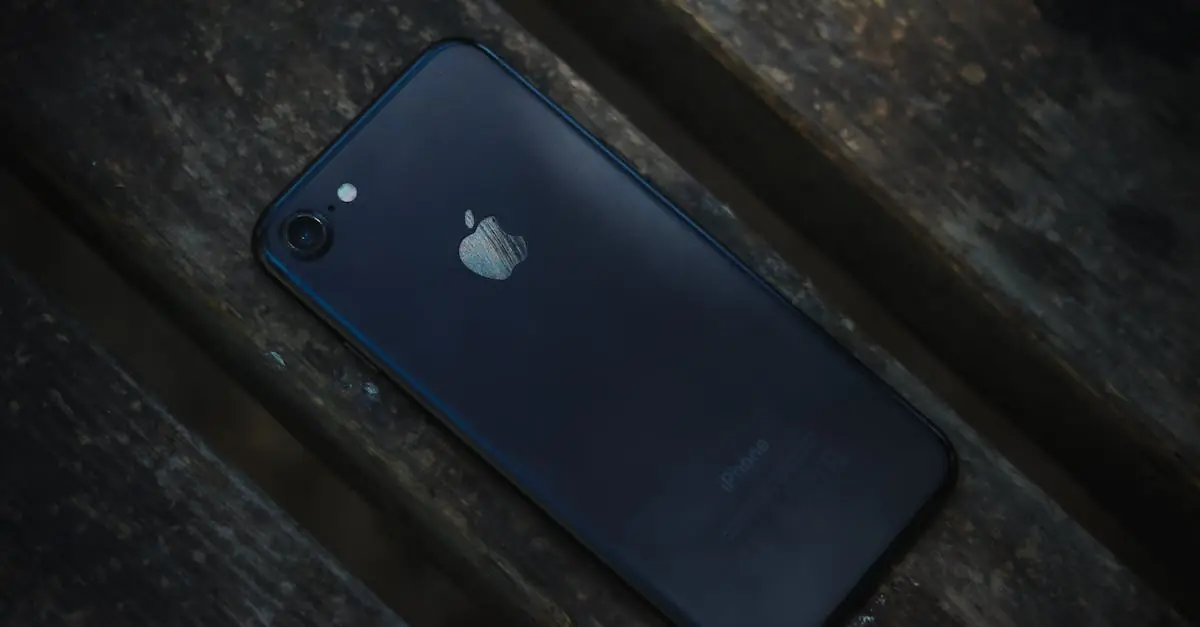Table of Contents
ToggleImagine this: you’re ready to dive into your favorite app, but your iPhone screen looks like it’s auditioning for a role in a noir film. The brightness is cranked up to eleven, yet everything still resembles a shadowy mystery. It’s enough to make anyone question their sanity or the very existence of the sun.
Understanding The Issue
An iPhone screen appearing dark despite maximum brightness can stem from several factors. Identifying these causes is essential for restoring proper functionality.
Common Causes of Dark Screen
Automatic brightness adjustment often plays a role in this issue. When enabled, the iPhone uses ambient light sensors to modify brightness levels, sometimes resulting in unexpected dimness. Low Power Mode may also influence screen brightness settings, favoring battery conservation over visibility. Additionally, device settings like Night Shift or True Tone can create warmer color temperatures, which might make the screen appear darker. Software bugs in iOS can diminish screen brightness unexpectedly. Lastly, physical damage to the display itself might cause permanent discoloration or darkness.
Importance of Brightness Settings
Brightness settings significantly impact screen visibility and user experience. Appropriate brightness ensures ease of reading and interaction in various lighting conditions. This balance is essential to prevent eye strain, particularly in low-light scenarios. Users benefit from understanding how settings like ‘Night Shift’ or ‘True Tone’ influence their display. Mastering these settings leads to optimal performance and usability. Regular checks on brightness configurations can help maintain a well-functioning device, providing clarity and enhancing overall satisfaction.
Troubleshooting Steps
When an iPhone screen appears dark despite maximum brightness, several solutions can resolve the issue. Start with these troubleshooting steps to get the display functioning properly.
Restarting Your iPhone
Restarting the device often resolves minor software glitches. Press and hold the side button along with the volume button until the power off slider appears. Drag the slider to turn off the iPhone. After the device powers down, wait about 30 seconds, then press and hold the side button again until the Apple logo appears. This simple action can refresh the system and restore normal brightness levels.
Checking Accessibility Settings
Accessibility settings might inadvertently affect the display. Navigate to Settings, then select Accessibility. Look for options like Display and Text Size. Ensure features such as Reduce White Point or Invert Colors aren’t enabled, as these can dim the screen. If any of these options are turned on, disabling them can enhance visibility.
Adjusting Display Settings
Adjusting various display settings can also help. Open Settings and go to Display & Brightness. Check if the True Tone and Night Shift features are active, as they may alter the screen’s appearance. Turning off Night Shift will revert the screen color temperature, while disabling True Tone can return brightness to original levels. Make sure to modify these settings based on personal preferences for optimal display quality.
Possible Hardware Issues
A dark screen on an iPhone, even with brightness adjusted to maximum, might indicate hardware problems. Various components could influence the display’s performance, making it essential to check specific elements.
Inspecting the Display
Check for physical damage on the iPhone screen, including cracks or scratches that might affect brightness. A damaged display can cause light distribution issues, leading to a darker appearance. Look for moisture under the screen, as it may impact functionality. Inspect connections and cables if the device has undergone repairs or screen replacements. Ensure that all components securely connect, as loose connections can result in display problems.
Testing with Different Apps
Test the brightness capabilities through various applications to identify app-specific issues. Some apps might have their own brightness settings or effects, causing discrepancies in screen visibility. If certain apps display a darker interface, consider updating or reinstalling them. Explore default apps, as they typically conform to system brightness settings, providing a baseline for comparison. Make a note of settings across frequently used apps to recognize patterns in brightness inconsistencies.
Preventive Measures
Keeping an iPhone screen bright and responsive involves regular maintenance and awareness of settings. Users should take proactive steps to avoid dark screen issues.
Keeping iOS Updated
Regularly updating iOS ensures access to the latest features and bug fixes. Apple provides updates to improve performance and address known issues, including display anomalies. Activating automatic updates allows users to receive necessary updates without manual intervention. Frequent checks for updates encourage users to maintain optimal device functionality.
Using Screen Protectors Wisely
Choosing a high-quality screen protector can enhance visibility. Some screen protectors may reduce brightness or alter color perception, leading to a darker display. It’s recommended to select protectors specifically designed to minimize glare and preserve screen clarity. Regularly checking for dust or debris under the protector helps maintain screen brightness. Proper installation of the screen protector ensures an unobstructed view and optimal performance.
Dealing with a dark iPhone screen can be frustrating but understanding the potential causes and solutions can make a significant difference. By following the troubleshooting steps outlined and regularly checking settings, users can often restore brightness and improve their overall experience.
It’s crucial to stay proactive by keeping the device updated and ensuring that any physical damage is addressed promptly. With these measures in place, users can maintain optimal screen performance and enjoy their iPhone without the annoyance of a dim display.








